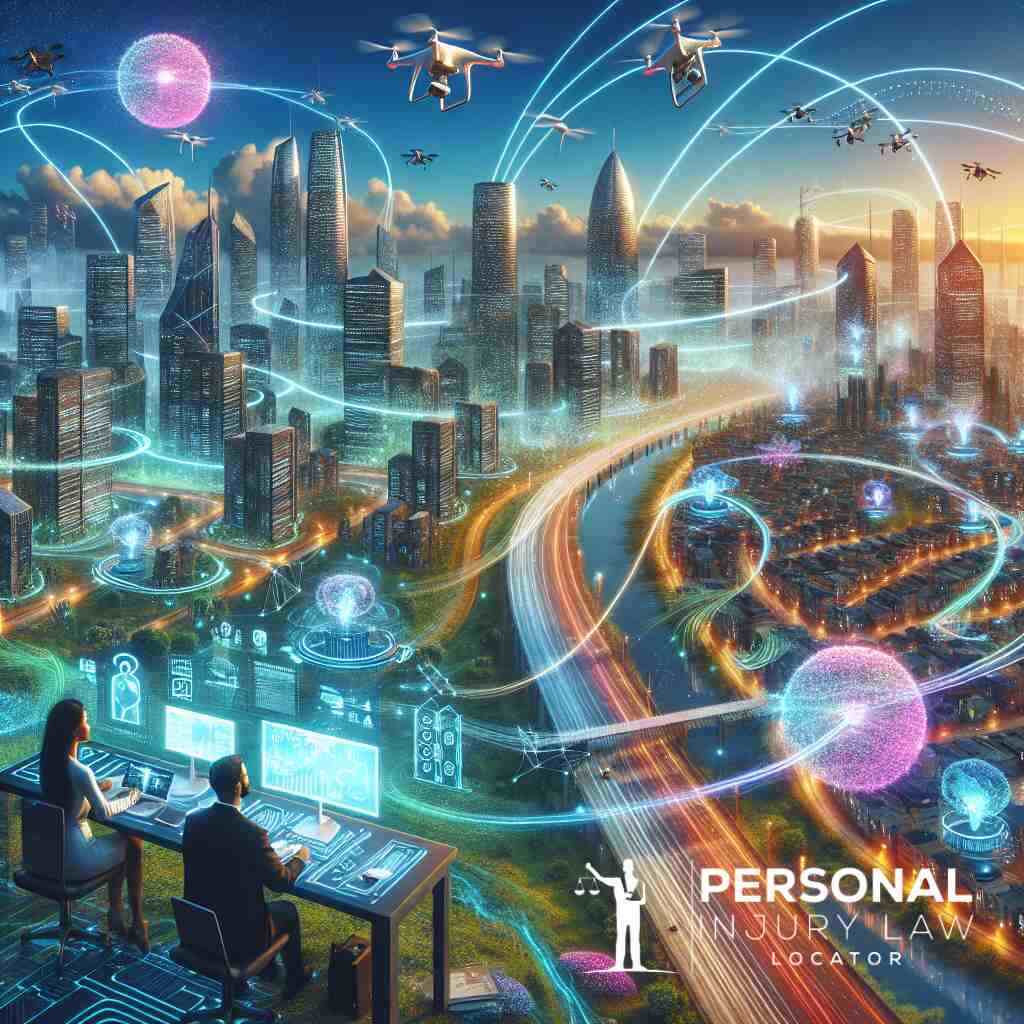 Posted On: 01/16/2025
Posted On: 01/16/2025Embracing the Future: The Evolution of Personal Injury Attorneys
The Dynamic Legal Landscape of 2025
As we delve into 2025, the legal landscape undergoes profound transformations. Personal injury law evolves rapidly, influenced by technological advancements and an increasingly complex regulatory environment. These changes redefine the role of a personal injury lawyer in California. In this dynamic landscape, attorneys must remain agile, adopting new legal technology to offer superior service. Increased scrutiny from insurance companies necessitates thorough, comprehensive case preparation. Attorneys must pivot quickly, adapting strategies to remain competitive in this fast-evolving field.
Emerging Challenges in Personal Injury Law
With emerging challenges in 2025, personal injury attorneys face intricacies like evolving malpractice laws and negligence complexities. The intersection of technology and law presents issues such as integrating digital evidence and managing increasing volumes of data. The pursuit of just compensation becomes more intricate as courts demand robust evidence for physical and emotional distress claims. Navigating these challenges requires advanced litigation strategies, with legal teams leveraging innovative solutions to unearth critical evidence and develop persuasive arguments. As these obstacles persist, attorneys must demonstrate expertise and agility in adapting to the new challenges.
Transformative Innovations Shaping the Legal Field
Transformative technological innovations revolutionize the legal field in 2025. AI tools, such as natural language processing and predictive analytics, enhance legal research and case strategy development. These advancements bolster the capabilities of a personal injury lawyer in New York, providing insights that enrich decision-making. Moreover, blockchain technology offers secure pathways for managing documents, ensuring transparency, and mitigating risks associated with data breaches. Virtual and augmented reality enhancements lead to immersive courtroom experiences, reshaping how evidence is presented. These innovations empower attorneys to optimize their practice, ensuring client success in an evolving legal environment.
Tech-Driven Advocacy: Leveraging AI and Digital Tools
AI Empowerment in Litigation Strategies
In 2025, personal injury attorneyswill harness AI to revolutionize litigation strategies. Artificial intelligence enhances case analysis, enabling attorneys to identify patterns in past cases and predict potential outcomes. This technological empowerment allows a personal injury lawyer in Florida to tailor strategies that maximize client success. AI-driven simulations recreate accident scenarios, providing an in-depth understanding of events leading to physical injuries. By integrating these innovations, legal teams can bolster their arguments with compelling evidence, ensuring a higher success rate in personal injury claims management.
Virtual Consultations and Digital Client Engagement
The era of virtual consultations reshapes how personal injury lawyers interact with clients. Digital tools facilitate seamless communication, breaking geographical barriers and fostering a more accessible legal process. Clients can engage with a personal injury lawyer in Texas from the comfort of their homes, ensuring prompt legal advice and representation. Digital platforms streamline consultations, enabling efficient client engagement while reducing the need for physical meetings. This evolving digital landscape allows attorneys to reach a broader audience, providing personalized legal solutions tailored to individual cases.
Legal Analytics and Data-Driven Decision Making
Data-driven decision-making is crucial for personal injury law in 2025. Legal analytics offer profound insights into civil cases, empowering attorneys to make informed decisions based on a wealth of data. Analytics tools examine verdict patterns, providing lawyers with valuable foresight in negotiating settlements for pain and suffering compensation. Moreover, data-driven insights guide injury attorneys in crafting strategies that align with the latest personal injury law trends. By leveraging these powerful tools, law firms can enhance their competitive edge, ensuring successful outcomes in complex personal injury lawsuits.
Automation in Legal Research and Document Management
Automation streamlines legal research, transforming how attorneys manage voluminous data and documentation. Advanced tools automate routine tasks, allowing personal injury lawyer insights that would typically demand significant manual effort. Automation enhances document management, improving accuracy and efficiency while minimizing human error in the legal process. By embracing this evolution, personal injury attorneys can focus on developing cutting-edge litigation techniques. Efficient document handling ensures that attorneys can quickly access critical information, presenting well-informed arguments that drive successful case resolutions.
Client-Centric Approaches: Revolutionizing Legal Services
Personalized Legal Solutions for Individual Needs
In 2025, personal injury attorneys will increasingly prioritize personalized legal solutions tailored to each client’s unique circumstances. By understanding individual needs, attorneys craft strategies that directly address the specifics of each personal injury case. This approach includes analyzing the type of injury, medical treatment requirements, and the legal process involved, enabling a comprehensive response to client concerns. By embracing these client-centric strategies, attorneys can guide injured parties through emotional distress and complex legal challenges. This focus on personalization not only enhances client satisfaction but also elevates the reputation of firms like Personal Injury Law Locator, known for their adaptability and commitment to securing favorable outcomes.
Enhancing Client Relationships through Remote Legal Assistance
The shift towards remote legal assistance transforms client-attorney interactions by making legal services more accessible in the digital age. Virtual consultations facilitate prompt engagement, allowing injured individuals to connect with a personal injury lawyer in Illinois efficiently. This seamless, tech-driven engagement helps bridge geographical distances, thereby expanding the reach of legal services across multiple states. By fostering a robust online presence and employing state-of-the-art communication technologies, law firms provide swift responses to client queries, alleviating stress for individuals navigating personal injury claims. As remote legal assistance becomes the norm, maintaining adept virtual communication is critical in fostering long-term client relationships and trust.
Responsive and Eco-Friendly Law Practices
The integration of eco-friendly practices within personal injury law firms aligns with the growing emphasis on sustainability in professional environments. Lawyers increasingly adopt paperless operations, leveraging cloud-based document management systems to reduce waste and enhance efficiency. This commitment to sustainability minimizes environmental impact while also streamlining the legal process. Firms like Personal Injury Law Locator are at the forefront, leading the charge towards more responsible legal practices. By incorporating eco-friendly solutions, attorneys not only reduce carbon footprints but also demonstrate a commitment to broader societal values, which clients increasingly appreciate. As the legal field progresses, combining responsiveness with environmental consciousness represents a defining characteristic of modern personal injury law practices.
Innovative Evidence Gathering and Case Presentation
Augmented Reality in the Courtroom
Augmented reality is revolutionizing courtroom presentations in 2025. This cutting-edge technology allows attorneys to create vivid, immersive recreations of accident scenes, providing an unparalleled perspective for judges and juries. By leveraging AR, personal injury lawyers can demonstrate complex events with precision, helping to convey the impact of physical injuries and emotional distress more effectively. This innovation transforms typical courtroom proceedings into dynamic, engaging experiences, offering clarity that traditional methods often lack. The integration of AR not only enhances legal arguments but also captures the undivided attention of those involved in the legal process, setting the stage for more persuasive case presentations.
AR technology also supports interactive evidence examination, allowing participants to interact with virtual representations of evidence. This capability provides a new dimension of understanding, allowing for a deeper appreciation of the nuances involved in personal injury cases. As this technology evolves, attorneys adept in its use can gain a distinct advantage, offering clients more comprehensive representation. By bridging digital and physical realms, AR enriches the narrative of each case, transforming how legal teams work with evidence in pursuit of favorable outcomes.
Drone Technology for Comprehensive Evidence Collection
In 2025, drones offer a powerful tool for gathering comprehensive evidence in personal injury cases. Equipped with high-resolution cameras and advanced sensors, drones can capture intricate details of accident scenes, providing invaluable visual documentation for legal teams. This technology is essential for personal injury attorneys who require detailed evidence to substantiate claims of negligence and liability. Drones enable rapid and safe data collection from locations that may be otherwise inaccessible, ensuring that no critical piece of evidence goes unnoticed.
Drone technology also facilitates the reconstruction of accident scenarios, offering attorneys a bird’s-eye view of events. This perspective is crucial in understanding the context and dynamics of an incident, supporting more accurate case evaluations. By integrating drone-captured evidence into their strategies, attorneys can enrich their case presentations with compelling visual narratives. This approach not only aids in illustrating the extent of property damage and personal injuries but also enhances the credibility of the personal injury claims being made.
Blockchain for Secure and Transparent Legal Practices
Blockchain technology emerges as a pivotal innovation in securing and streamlining legal practices in 2025. This decentralized ledger provides robust solutions for managing sensitive client information, ensuring transparency, and reducing the risk of data tampering. By implementing blockchain, personal injury law firms can protect client details and sensitive case information from unauthorized access, reinforcing trust in their legal services. This protection is critical in maintaining the integrity of the legal process , and safeguarding against potential cybersecurity threats.
The implementation of blockchain also enhances the management of legal documents, offering a tamper-proof method of tracking changes and verifying document authenticity. This innovation is particularly beneficial in the documentation-heavy field of personal injury law, where accuracy and reliability are paramount. Additionally, the transparent nature of blockchain supports heightened compliance with evolving regulatory standards, facilitating seamless integration into existing legal frameworks. As firms continue to adopt blockchain solutions, the transformation towards more secure and efficient legal practices becomes evident, positioning them tto serve clients in an increasingly digital landscape better
Cybersecurity and Ethical Considerations
Safeguarding Client Information in a Digital Age
In 2025, safeguarding client information becomes paramount as personal injury attorneys increasingly handle sensitive digital data. The rise in virtual operations demands robust cybersecurity measures to protect against breaches and unauthorized access. Personal injury law firms employ cutting-edge technologies, including advanced encryption and multi-factor authentication, to ensure data integrity. As the digital landscape evolves, so does the sophistication of cyber threats, necessitating constant vigilance, and updates to security protocols. Such proactive measures not only protect client interests but also cement trust in legal services, reinforcing a law firm’s reputation for reliability and discretion.
Moreover, the legal field’s reliance on digital tools mandates a comprehensive approach to data protection. Law firms must ensure that all personnel understand cybersecurity protocols, fostering a culture of responsibility and awareness. By prioritizing these practices, attorneys can securely manage digital case files and communications, thereby promoting transparency and confidence among clients.
Addressing Ethical Challenges in Technology-Integrated Practices
As personal injury attorneys integrate more technology into their practices, ethical challenges emerge. The use of AI-driven tools and data analytics must align with ethical standards, ensuring fairness and impartiality in legal proceedings. Attorneys bear the responsibility of maintaining client confidentiality while leveraging technology to advance case outcomes. Navigating ethical considerations involves understanding the impact of technology on decision-making processes and ensuring that the use of innovations like AI does not compromise justice.
The legal community must engage in ongoing dialogue about the ethical implications of technology in law. This discourse fosters a deeper understanding of how technology can aid or hinder the pursuit of justice in personal injury cases. By addressing ethical challenges proactively, law firms can implement technology in ways that benefit clients without sacrificing ethical integrity.
Compliance and Risk Management for Law Firms
In the rapidly evolving legal landscape of 2025, compliance and risk management are crucial for law firms handling personal injury claims. Legal professionals must stay abreast of changing regulations and compliance standards to avoid legal pitfalls. Utilizing technologies like blockchain, personal injury attorneys can enhance transparency and ensure compliance with data management regulations. Blockchain’s immutable nature provides a reliable mechanism for document authentication and audit trails, which is essential in meeting compliance requirements.
Risk management also involves preparing for potential cyber threats and implementing strategic plans to mitigate vulnerabilities in digital operations. By instituting comprehensive risk assessments and contingency plans, law firms can protect their assets and clients against unforeseen disruptions. This proactive approach underscores a firm’s commitment to upholding the highest standards of legal practice in an increasingly complex digital era. As attorneys rise to meet these challenges, they position themselves as leaders in safeguarding both legal and ethical standards in personal injury law.
Conclusion: The Personal Injury Attorney of Tomorrow
Key Takeaways on 2025 Legal Trends
As we explore the legal landscape of 2025, several pivotal trends emerge, shaping the way personal injury attorneys conduct their practice. The integration of advanced technologies like AI, blockchain, and augmented reality has become indispensable in streamlining legal procedures and enhancing client interactions. Law firms are increasingly adopting eco-friendly practices, reflecting a commitment to sustainability that resonates with client values. Moreover, the emphasis on personalized legal solutions highlights the necessity for attorneys to adapt strategies that align with each client’s unique circumstances. With these developments in mind, keeping abreast of personal injury law trends becomes more crucial than ever to maintain a competitive edge in a rapidly evolving field.
The Future Role and Responsibilities of Personal Injury Attorneys
The role of personal injury attorneys is expanding, with an increased focus on leveraging technology to improve case management and outcomes. Adapting to innovations such as AI-driven analytics, virtual consultations, and digital client engagement is essential. This technological adeptness enables attorneys to offer more efficient and effective solutions to clients facing complex legal challenges. Personal injury attorneys must also prioritize cybersecurity and ethical considerations, ensuring that all digital practices uphold the highest standards of client confidentiality. As practitioners navigate the future of legal services, they will adopt a more proactive approach to risk management, ensuring compliance with evolving regulations and maintaining the trust of clients and the public.
Preparing for a Tech-Infused Legal Career
Embracing the tech-driven future of personal injury law requires both strategic preparation and a willingness to innovate. Future attorneys will need to cultivate skills in technology management and data analytics, enabling them to harness digital tools for optimized decision-making and case strategy. Training in ethical practices related to technology use will be crucial, ensuring that advanced tools enhance rather than detract from justice. As the demand for tech-savvy legal professionals grows, continuing education and professional development become vital pathways for aspiring attorneys to remain relevant. As they engage in this ongoing learning journey, attorneys will find themselves well-equipped to thrive in an industry increasingly defined by technological ingenuity and client-centered approaches.
Frequently Asked Questions
Question: How are AI and digital tools reshaping litigation strategies for personal injury attorneys in 2025?
Answer: In the rapidly evolving legal landscape of 2025, AI and digital tools have transformed how personal injury attorneys manage cases. What Are Advanced Strategies in Injury Litigation? These technological advancements enhance case analysis by studying patterns from past cases, allowing attorneys to predict potential outcomes with greater accuracy. AI-driven simulations offer detailed insight into accident scenarios, thus enriching the evidence presented in personal injury claims. Personal Injury Law Locator connects clients to forward-thinking attorneys who ar well-versed in utilizing these tools, ensuring superior legal representation that prioritizes client success.
Question: What role does blockchain play in secure legal practices for personal injury law?
Answer: Blockchain technology will be pivotal in securing and streamlining legal practices in 2025. It will provide a decentralized ledger system that ensures transparency and reduces risks of data tampering. Personal Injury Law Locator’s affiliated law firms leverage blockchain to protect sensitive client information, enhancing trust and integrity in legal services. This technology is especially beneficial for managing legal documents, as it offers a tamper-proof method for changes and validates document authenticity, which is crucial in personal injury cases where accuracy is paramount.
Question: How does the Personal Injury Law Locator help in finding the right personal injury attorney to handle futuristic cases?
Answer: As the legal field evolves, finding the right attorney who is adept with futuristic approaches is vital. Personal Injury Law Locator connects individuals with specialized attorneys who are leaders in incorporating innovative legal solutions, such as augmented reality for courtroom narratives and drones for evidence gathering. How Does a Personal Injury Law Locator Reinvent Wrongful Death Claims? Our network ensures that clients receive representation tailored to modern legal challenges, thus enhancing the likelihood of achieving optimal settlements and verdicts in personal injury lawsuits.
Question: What are the benefits of virtual consultations and remote legal assistance in 2025 for personal injury claims?
Answer: Virtual consultations and remote legal assistance have revolutionized client engagement by removing geographical barriers and allowing prompt access to legal services. Virtual Consultations and Remote Legal Assistance Through Personal Injury Law Locator, clients can connect with personal injury attorneys from any location, ensuring efficient legal representation. This approach not only provides convenience but also expands the accessibility of personalized legal services tailored to the unique needs of each case, demonstrating our commitment to innovative, client-centric legal solutions.
Question: Why is augmented reality considered a game-changer in courtroom presentations for personal injury attorneys in 2025?
Answer: Augmented reality (AR) is reshaping courtroom presentations by offering immersive, detailed recreations of accident scenes, providing judges and juries with a precise understanding of events. Comparing Negligence and Liability in Injury Cases This innovative technology enhances the impact of legal arguments by vividly demonstrating the nuances of personal injury claims. Attorneys affiliated with Personal Injury Law Locator are at the forefront of integrating such cutting-edge techniques, ensuring a compelling narrative that strengthens the client’s case, thereby leading to more successful outcomes.




